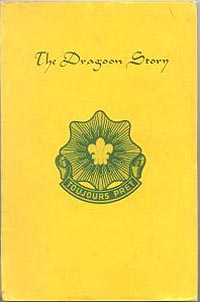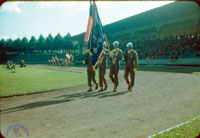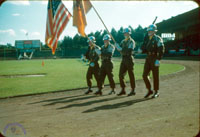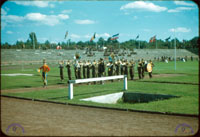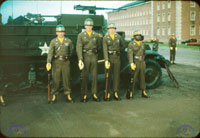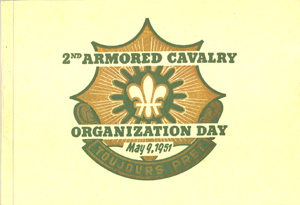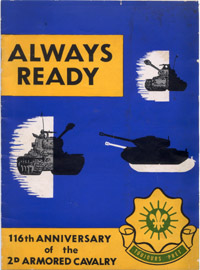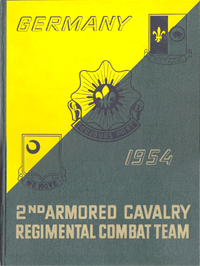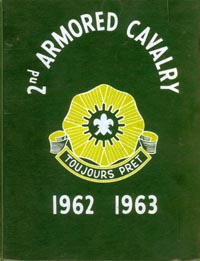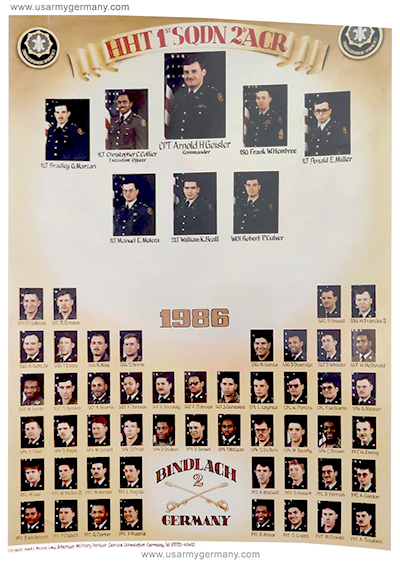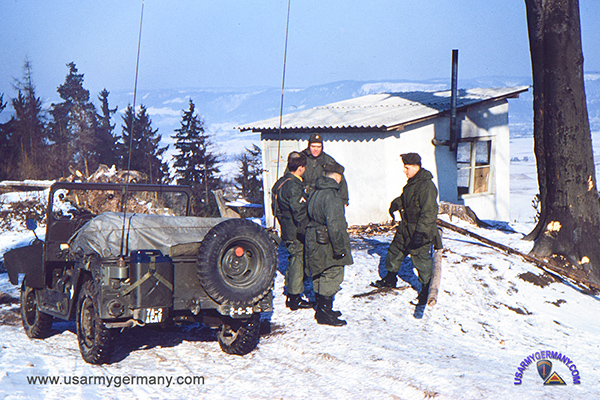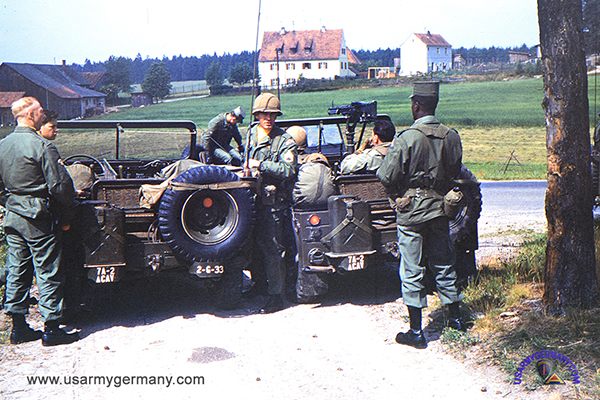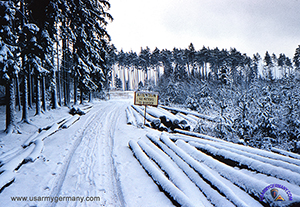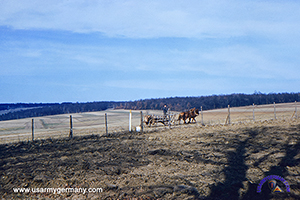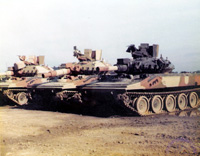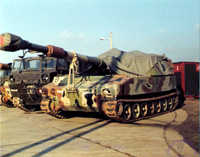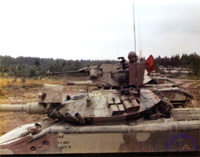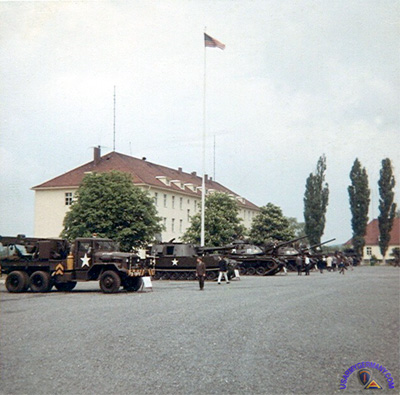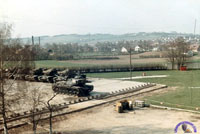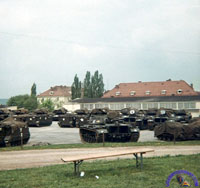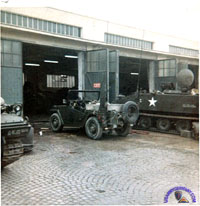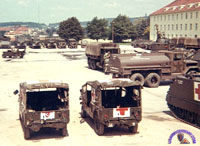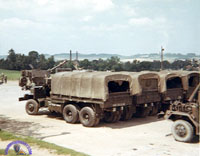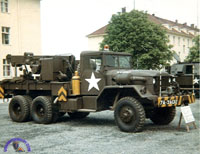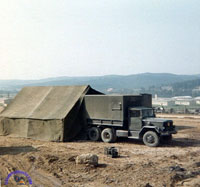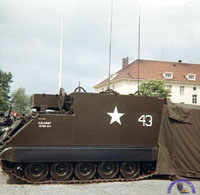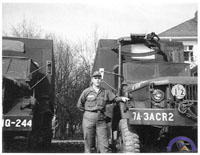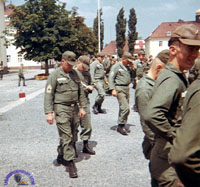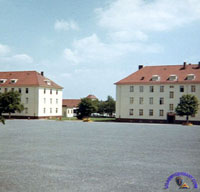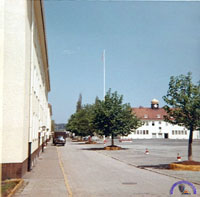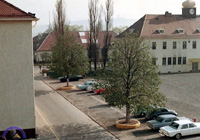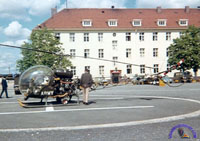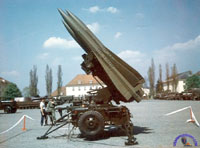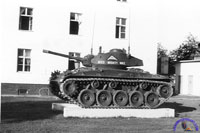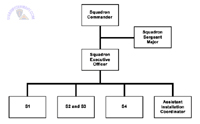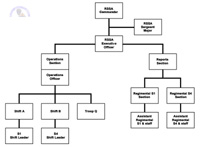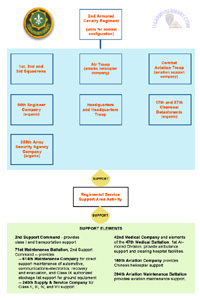| If you do
NOT see the Table of Contents frame to the left of this page, then
Click here to open 'USArmyGermany' frameset |
||||||||||||||||||||
|
2nd Armored Cavalry Regiment |
||||||||||||||||||||
|
|
||||||||||||||||||||
|
||||||||||||||||||||
|
|
||||||||||||||||||||
| Regimental History | ||||||||||||||||||||
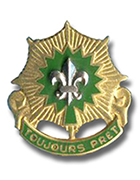 2nd Armored Cavalry Regiment crest 2nd Armored Cavalry Regiment crest |
||||||||||||||||||||
| 1945 - August 1955 | ||||||||||||||||||||
| Sources: (1) "Ghosts of Patton's Third Army - A History of the Second US Cavalry," Maj A.L. Lampert and Capt G.B. Layton. Münchner Graphische Kunstanstalten GmbH, 1946. (2) "Always Ready. 116th Anniversary of the 2d Armored Cavalry," Public Information Office, 2nd A/C Regiment. Stars and Stripes, 1952. (3) "2nd Armored Cavalry Regimental Combat Team, Germany, 1954." 2nd ACR Yearbook. (4) "The Dragoon Story - A History of the 2nd Armored Cavalry Regiment, " by Wolf W. Schmoekel. Randall Printing Company, 1958. (5) "2nd Armored Cavalry, 1962-1963." 2nd ACR Yearbook. (6) "Border Operations." 2nd ACR Public Affairs Office, early 1980s |
||||||||||||||||||||
| (Source: The Dragoon Story - A History of the 2nd Armored Cavalry Regiment, by Wolf W. Schmoekel.) | ||||||||||||||||||||
| CHAPTER IX
- 1945-1956 Occupation and Guard on the Iron Curtain At the end of World War II the Second Cavalry Group, Mechanized, was screening the area between Pilsen and Nepomuk. The unit, as the most advanced element of the 3d Army, had reached that line on May 7 when orders were received to halt the advance. This was according to inter-Allied agreement on demarkation lines. Between the limits set forth for the U.S. and Soviet Armies in Czechoslovakia, a ten kilometer-wide buffer zone had been established. The Second was pushing patrols to the very limit of that zone in order to establish contact with the Russians, who had not yet appeared in that sector. Aside from this, the unit was occupied tactically with the apprehension of small groups of German soldiers, who were infiltrating from the east in order to avoid being taken prisoners by the Soviet. A platoon from B-42 fulfilled an additional task by guarding the German Prisoner Brigade Viechech. It was a disappointment to the men of the Second when the 4th Armored Division, to the south of the group sector, made first contact with the Russians. However, the group soon had its curiosity satisfied. During the night of May 9, a Soviet armored column roared into Nepomuk, intent on proceeding to Pilsen, which had been occupied by the 16th Armored Div. since early on May 8. The 42d Squadron, stationed in Nepomuk, had considerable difficulty in persuading the Russians that they had gone far enough. Apparently no word of the freeze order had reached them yet. The tankers of the Second were a little disconcerted when they found that there were female soldiers in the Red Army. On the following morning a patrol finally located the Russian Corps Commander, 25th Tank Corps, who also had to be convinced that there was no need to advance farther. A meeting was arranged with Lt. Colonel Hargis, commanding 42d Squadron; and on the I I th Colonel Reed escorted the Russian to a reception given by Major General Erwin, commanding general of the XII Corps. |
||||||||||||||||||||
|
||||||||||||||||||||
| As it became
apparent that no large force was needed to occupy an exhausted and
war-torn Germany, most of the American troops in the country were
gradually withdrawn. This caused an enlargement in the territory assigned
to each of the remaining units. The Second consequently had to move
elements into the counties of Viechtach, Regen, and Grafenau during
the summer and fall. During the same period the group was rapidly
depleted of the veterans who had been with it from Ft. Jackson to
Czechoslovakia. The great number of replacements received meant training
once again, to keep the outfit "second to none." At the end of 1945 it became clear that the occupation forces in Germany would have to be reorganized in order to carry out the great task assigned to this relatively small number of troops. At this time, the military was wholly responsible for policing the zone of occupation, and providing for the maintenance of security and order. Circumstances in Germany were all but chaotic, mass starvation threatened; and a black market flourished which was doubtlessly unprecedented in history. The problem was aggravated by millions of homeless people, displaced persons, and refugees, who were living in dilapidated camps without any means of making a livelihood. In addition, there was still fear (probably groundless) of an uprising or an organized resistance movement on the part of the German population. (As we shall see, there were actually some efforts made to bring such a movement into being, but in retrospect we can safely say that this probably never constituted a major danger.) All these factors made it necessary that a force be organized, which could be stationed in a central location; and would be able to rapidly reach any trouble spot, and deal with any contingency. Of the organizations then existing in the Army, the cavalry groups were best suited for such a mission. Consequently the Second was assigned the duties of a District Constabulary for the Eastern Military District (comprising essentially the State of Bavaria) as of January 1, 1946. The 42d Squadron set up its headquarters at Freising, and the 2d moved to Schwandorf. Before this move was completed, Troop A was ordered to Kempten, in the southwest corner of the state, to carry out a special mission; whose exact nature was kept secret even from the troops engaged in it. Arthur Axmann, a high ranking Nazi and for many years leader of the Hitler Youth, had been ascertained to be hiding at a remote farm near the Austrian border. Intelligence had learned that he had made several trips through Germany in attempts to organize a nationalist underground movement. Since it was imperative that Axmann be captured alive, it was impractical to arrest him at his hide-out, which could not be approached without being observed from the house. Past experience indicated that high Nazi leaders carried suicide capsules which would cause instantaneous death when bitten open and swallowed. For this same reason it was necessary that the arrest be made suddenly. Intelligence had been received to the effect that one of Axmann's collaborators would pick him up at a prearranged time for a meeting with other leaders of the projected underground group. Since Axmann was in the possession of forged papers, he had been able to pass routine road blocks before; and had no reason to avoid them. Troop A therefore set up checkpoints at all roads leading to Axmann's hide-out. All the troopers were well briefed on the Nazi leader's appearance, but did not know the identity of their quarry. This precaution was taken to prevent word of Axmann's capture leaking out before the CIC was ready to close in on his associates. A momentary crisis arose when an overexcited guard at a checkpoint stopped the car and gave its occupants reason to become suspicious. However, after some anxious waiting the car was finally stopped at a roadblock near Kempten, and Axmann was found to be in it. The occupants were asked into a house, as if to make a routine inspection of their papers, and then suddenly overpowered by a group of men from HQ Platoon under Lt. Pridgen. Axmann was later tried with the other top Nazi leaders at Nuernberg, and received a long prison sentence. In December 1945, General George S. Patton died in a highway accident. Colonel Charles H. Reed, a close personal friend of the General, was placed in charge of arrangements for the funeral. According to the wish of his widow, the great commander was laid to rest among thousands of men of his Third Army at an American cemetery near Luxembourg City. For the impressive ceremonies, the 2d Squadron furnished a color guard; and the 42d a mechanized escort squadron, which moved to Luxembourg in a forced march of four hundred miles on December 22/23. The District Constabularies were intended to be merely a temporary force while the plans for a permanent Zone Constabulary were worked out. A headquarters for this unit was established in January of 1946, and Major General Ernest N. Harmon, who had fought with the regiment in World War I, was appointed its first commander. Since none of the established tables of organization in the army fitted the mission of the constabulary, a new type of unit had to be developed. For the Second this entailed the return to regimental organization as one of nine Constabulary Regiments. On Jan. 15 the 2d Squadron moved to Sonthofen, where it established the Constabulary School. Another contribution of our unit was the design of its shoulder patch, the "Circle C." Between Feb. 15 and March 20 the Second reorganized for its new mission and became the 2d Constabulary Regiment. Within the organization there were three squadrons: the 2nd, the 42nd, and the new 66th, formed from the former 66th FA Battalion. These squadrons were composed of a HQ and Sv. Troop, three reconnaissance, and two mechanized troops each. In addition, the regiment included a Tank Troop, a Medical Detachment, and a motorcycle platoon. The cavalry tradition was upheld by a horse platoon, which furnished the color guard for several years; and did valuable work patrolling areas along the Czech border which were impassable to vehicles, while on detached duty with the 6th and 14th Constabulary Regiments. By April the squadrons had taken up their new stations. Regimental HQ and the 42d Squadron was at Freising; the 2d at Lenggries, and the 66th at Degerndorf, near the Austrian border. During the next few months the new organization was thoroughly tested by numerous practice alerts. By July 1, 1946 (the operational date) the U.S. Constabulary was all it was intended to be; an elite unit, highly mobile, and ready for instantaneous action. To demonstrate the latter, the 42d Squadron was alerted on a Saturday afternoon to move to a designated point one hundred twenty miles distant. Most of the men on pass, yet the unit managed to gather them, and arrive at its objective within six hours after the alert was given, with not a vehicle missing. At the same time the regiment also made a fine record in shooting competitions with other constabulary outfits, and remained unexcelled in athletics. The Second's new duties consisted mainly of police work, raids on black market centers, and an occasional show of force to discourage any would-be conspirators. A nation-wide black market ring was broken up in the fall of 1946. A platoon of C Troop-42, stationed at Ingolstadt, tracked down some men who had broken into the local food office and stolen a large number of ration stamps. It was discovered that they belonged to a well organized ring of black marketeers, who were subsequently arrested by American and British officials. That such police work occasionally entailed real excitement and danger is shown by a case which occurred late in 1946. The Third Platoon of C Troop-2 had been successful in identifying a group of bandits, who had committed a series of robberies and murders in the vicinity of Murnau. They finally tracked down two of the gang leaders to an isolated barn by extracting a confession from one of the men's wives. When the barn was surrounded one of the criminals came out; but the other, Kubala, refused to surrender. Sergeants May, Gibson, and Ftitsch, as well as a German policeman, finally entered the barn. They had to withdraw when May was badly wounded by a bullet in the chest. The platoon leader, still intent on taking Kubala alive, had the barn dismantled by a ten-ton wrecker. 'They found that the bandit had taken his own life rather than he caught. Aside from police duties, the Second also was one of the show outfits in Europe, and in that capacity participated in a goodly number of parades. Outstanding among these was one held in the impressive Königsplatz square in Munich for the Army Chief of Staff, General Dwight D. Eisenhower on October 14, 1946. The whole regiment had been assembled from its various stations. It passed in review in a long column of glistening vehicles, led by Colonel Reed and the staff on horseback. A few days before that, Colonel Reed and several other officers had participated in an inter-Allied horseshow at Innsbruck, Austria. The show was long remembered for the fine hospitality shown by the French hosts. Police duty continued to be the main mission of the Second through most of 1947. There were occasional thriller cases such as a quadruple ax murder, but for the most part duty consisted of routine operations combating the black market. This was made more difficult by regulations which forbade the troops to enter the camps of the so-called displaced persons. As they were under UNRRA supervision, the military had to have iron-clad proof of an offense. Because of this situation the unit finally resorted to a blockade. They set up road blocks surrounding the DP camp at Wolfratshausen, and checked every vehicle entering or leaving the camp. T'his was kept up for a week; and in the process great quantities of black market goods were recovered, and illegal activity was curbed for the time being. An important aspect of the service of the regiment throughout this period was its German Youth Activities program. A full time staff organized groups which conducted an active program, including everything from dances and crafts exhibitions to discussion groups. Much good will was built through this activity, and a sound foundation laid for better German-American understanding. In September of 1947 the Regimental Headquarters, and the 2d and 42d Squadrons moved to Augsburg, where the unit was joined by the 68th Squadron. Activity now began to center around training. The 66th Squadron, remaining at Degerndorf, continued its border patrol and police work. During late 1947 and continuing during the next year, the elements in Augsburg received intensive training in all military subjects. This included a course in air mobility which involved the loading of equipment on mock-up aircraft, and was climaxed by an actual flight in cargo plane. The coup by which the Czech government was taken over by the Communists did much to shift the emphasis in security from guarding against the scarcely existing Nazi danger to a new awareness of a real Communist threat. The actual police role of the Constabulary declined as the German police assumed fuller responsibilities, and the black market was dealt a mortal blow by a reform of the German currency in June of 1948. In December of that year the regiment was reorganized in accordance with the new tactical emphasis and became the 2d Armored Cavalry Regiment. However, it continued to be part of the U. S. Constabulary until that organization was abolished in 1952. The 2d Squadron became the 1st Battalion, and the 42d and 68th, the 2nd and 3rd Battalions respectively. The 66th Squadron was transferred out of the regiment. During the following years the unit was constantly engaged in training. One battalion was in the field at nearly all times to furnish aggressor details, for the unit tests and field exercises. The security platoon in HQ Co. continued to perform a secondary police mission, but was mainly concerned with processing complaints and forwarding them to higher headquarters. The emphasis was once more on combat readiness; particularly after June 1950, when the Reds struck in Korea. There were many large scale maneuvers and map exercises, six in 1951 alone. The largest of these operations, "Combine," took place in the fall of that year; and was held in the British Zone, with British troops participating. Earlier in the year, the regiment had cooperated with French forces in Exercise "Jupiter," which had involved over one hundred and fifty thousand men. Most of the time the regiment was designated as part of the Aggressor forces, and there was a lot of griping about the necessity of being "defeated" every time. In October of 1951 the regiment moved to the Nuernberg area. Regimental Headquarters was established in that city, as was the rest of the Provisional Battalion. The other battalions took up stations at Bindlach near Bayreuth (1st), Bamberg (2d), and Amberg (3d). Detachments from the 1st Bn. were also stationed at Hof and Arzberg (later discontinued), and the 2d Battalion had companies at Kronach and Coburg. These detached units were rotated at regular intervals. In addition to maintaining combat readiness, the regiment now had a new mission. This was to patrol the border in cooperation with the new German Border Patrol Police. It was a strange feeling for the troopers to stand on the very fringe of the Iron Curtain; knowing that this was not a boundary like any other, but a dividing line between two utterly opposed ways of life. Occasionally they spoke to refugees who managed to cross that border, in spite of all measures on the part of the Communists to prevent them; and they knew that the land across the line was in the grip of a tyranny such as man had never known. There was pride in the knowledge that they, the men of the Second Cavalry, now stood guard on the edge of freedom. Occasionally shots were fired from across the line, and our soldiers replied. Such incidents were rare; and border patrol for the most part meant weariness, bad weather, and long hours. For the regiment it meant that there was a job to be done. In the meantime training was kept up; and each unit semi-annually spent two weeks at Grafenwoehr, a former German training camp. Here field maneuvers were held, and range firing conducted. The traditions of the regiment were not neglected during this period. During 1948 a new color guard was organized, clothed in the uniforms of the dragoons of 1836. This fine group has marched ahead of the regiment at all formal occasions since, a constant reminder of the brave past of the Second. In 1951 the deactivated 2d, 19th, and 776th Tank Battalions were consolidated with the regiment from which these outfits had been organized back in 1942. This added the streamers "Leyte" and "Ryukyus" to the unit's colors, and gave us the right to wear the Presidential Unit Citation won by the Second Tank Battalion at Bastogne. In 1952 the Second invited the French Conde Dragons and the British Queen's Bays, the "2d Dragoons" of their respective armies, to send representatives to its organization day celebration. This visit led to a close relationship among the three units, and visits were exchanged regularly on ceremonial occasions during the remainder of the unit's service in Germany. The Second, throughout its stay in Germany, remained the magnificent outfit that had fought under Patton. Its role changed from occupation force to defense force, its mission from police duty to tactical readiness, its name from Cavalry to Constabulary, and back to Cavalry. Yet the Second was always prepared, always ready to do its duty. Relations with the German civilian population, so important in view of that country's reestablishment as a sovereign power, became notably good in spite of difficulties. There were a few things such as damage to farmers' crops during maneuvers (for which the owners received full compensation), and occasional cases of troopers getting out of hand. This was outweighed by the good will the Second built up by participating in many charitable projects; such as Christmas parties for underprivileged children, and its fine Youth Activities program. A good public information program also helped relations; and Germans were invited to parades, organization day celebrations, and other activities. When the regiment left Germany, the Lord Mayor of Bamberg presented a scroll to the Second Battalion; praising the unit for its fine part in creating better U.S.-German relations. The regiment showed that it could not only defeat an enemy, but also win friends. The Second Cavalry returned to the United States during the summer of 1955. They exchanged stations with the 3d Armored Cavalry under the Army's "Operation Gyroscope," which brought about a return to rotation by unit, rather than by individual. An advance party flew to the States in June 1955, and arranged the many details the regiment's new station. The regiment left Europe, its home for over eleven years, in the middle of August. The 1st and 2d Battalions embarked at Bremerhaven aboard the transport USS Buckner and arrived in New York on August 22. The Provisional and 3d Battalions followed two days later, completing the final leg of the journey to Ft. George Meade, Md., by rail. Upon arrival many of tile men, whose term of service was about to expire, were discharged; and the others were granted leaves in two groups. As soon its the regiment was settled at its new station, it went to work again. It had to get the equipment that had been left by the 3d Cavalry into top shape for inspections which came thick and fast. Since then the unit has been conducting basic and advanced training to provide replacements for its sister regiment, the 3d, and for other units. At all times its high state of combat readiness has been maintained by inspections, and field training at Camp A. P. Hill, Va., and Ft. Stewart, Ga. Ceremonial occasions mean parades, and a proud moment came for the unit when a picked company marched down Pennsylvania Avenue in the parade honoring President Eisenhower's second inauguration on January 21, 1957. At present the regiment is made up of three battalions. Each has its own headquarters company, three reconnaissance, a howitzer, and a tank company. The Regimental Headquarters Company, Service Company, and Medical Detachment complete the unit's makeup. The latest outfits to join the 2d Cavalry family were the three howitzer companies. Along with several other supporting units they had been attached to the regiment in Germany as the 70th Armored Field Artillery Battalion. With their addition, the unit now combines the punch of artillery with its traditional armor and infantry roles, to make up a powerful, well balanced striking force. Yes, the Second Cavalry is still following its motto. In spite of all the changes that the last one hundred and twenty years have brought; devotion to duty, and the ability and willingness of the cavalry to be first on any field have remained unchanged. The "Dragoons" have a glorious history to be proud of, and the regiment can be trusted to uphold its fine tradition whenever and wherever it may be called upon. Captain May and Colonel Cooke, Sergeant Hagan, Major Pleasonton, and all the others have ridden into history; but it was they who shaped their regiment's present by setting a standard that we must live tip to. Therein lies the meaning of military tradition. Keep this in mind and adhere to our high standard: this is our challenge. Thus the future of the Second will always be equal to its past. |
||||||||||||||||||||
|
|
||||||||||||||||||||
|
OCCUPATION PERIOD |
||||||||||||||||||||
|
||||||||||||||||||||
|
|
||||||||||||||||||||
| 1951 | ||||||||||||||||||||
| (Source: 2nd Armored Cavalry Organization Day, May 9, 1951. 2nd ACR, Germany, 1951) | ||||||||||||||||||||
|
||||||||||||||||||||
| 1952 | ||||||||||||||||||||
| (Source: Always Ready, 116th Anniversary of the 2nd Armored Cavalry. 2nd ACR PIO, Germany, 1952) | ||||||||||||||||||||
|
||||||||||||||||||||
|
|
||||||||||||||||||||
| 1954 | ||||||||||||||||||||
|
||||||||||||||||||||
| 1958 | ||||||||||||||||||||
| (Source: STARS & STRIPES, Feb 17, 1958) | ||||||||||||||||||||
| 1st Group of 2d Cav Lands in Germany To Replace 3d Cav BREMERHAVEN, G e r m a n y (Special) -- The first of two increments of the 2d Armd Cav Regt arrived at the Army Port of Embarkation here from Ft. Meade, Md., on a Gyroscope move to replace the 3d Armd Cav Regt on border patrol duty along the Iron Curtain. The first increment included about 1,500 troops and their dependents, Port officials said. The second increment was scheduled to reach here Monday. Col Gordon L. Barclay, VII Corps adjutant general, officially welcomed the 2d Armd Cav to Germany in dockside ceremonies. Accompanying Barclay on the reviewing stand here was Col Irving W. Brooks, port Co. The arrival of the 2d Cav here completed a Gyroscope cycle which began when the unit left Germany for Ft. Meade in August 1955. The 3d Armd Cav Regt replaced the 2d then, officials pointed out, and now the 2d is replacing the 3d. |
||||||||||||||||||||
| 1963-63 | ||||||||||||||||||||
|
||||||||||||||||||||
| Command & Control Squadron, 2nd ACR | ||||||||||||||||||||
| 1977 | ||||||||||||||||||||
| (Source: Email from John Barradale) | ||||||||||||||||||||
| 2nd Armored Cavalry Regiment, C&C Squadron (based in Nurnberg, Germany). Combat Aviation Troop – Fuecht Army Airfield.
I flew the OH-58, Bell scout helicopter as an Aerial Scout (MOS = 19D15F).
I spent three years+ there from 1977 through 1981.
We had this one troop with about six or so OH-58, don’t remember the exact number. Captain as commander, pilots, aerial scouts and crew chiefs. The second unit was the Cobra gunships. Do not remember the unit name. Both of these troops were barracked in Nurnberg, and stationed at Feucht. I was trained to fly the OH58 even though I was not an officer. A program that the commander implemented to increase the coverage of his OH-58s. I got there just as they were getting rid of the light tank, M551 Sheridan. While in Germany a crew was killed by a round fired from a tank that passed by the searchlight tank because they failed to turn the turret down range. AP round might have failed to penetrate because of the special armor it had. But, the round was a solid metal round and went right through it. M60 replaced most of the tanks in use later on before the M1 came out. I also just missed the new German Style helmets. They took away our berets that we had, so the CO came up with an Army Ranger style soft cap. He just did not like the idea of wearing something that everyone else was. Espirit de corps ! Panash he called it. Some stupid Congressman made us get rid of the berets because it was an imposition on recruits from poorer families or some other such garbage. One alert we went on. In 1980 I think, a report from one of the M113s on the border reported “fifty vehicles on the Ghost Autobahn”, the highway from Munich to Berlin. An attempt to contact the vehicle to confirm what kind of vehicle failed. Alert went up and we loaded live missiles on the gunships for the first time in the unit’s history. About a few seconds before crossing the border and starting WW3, a message came back that it was just some trucks. We turned away and saved the world. Also just remembered. I think our Commander was Colonel Robert Wagner. Very gung ho. He beat the 1st Armored Division in a combat exercise. He did it with a Lieutenant and driver with a jeep and radio on top of a hill. Kept them on the wrong side of the river for a whole day. 3rd Infantry Commander had the VII Corps Commander order him to stop and allow the 3rd Infantry in. They allowed the 1st Armored to cross the river and pushed the 3rd ID back. Our CO got angry and inserted 1 Squadron in a “Reconnaissance in Force” maneuver and pushed the 1st Armored back across the river. And of course the 3ID CO complained again and again allowed 1st Armored Division to cross the border. And again our CO came in and pushed them back across the river. |
||||||||||||||||||||
| 1st Battalion/Squadron, 2nd ACR | ||||||||||||||||||||
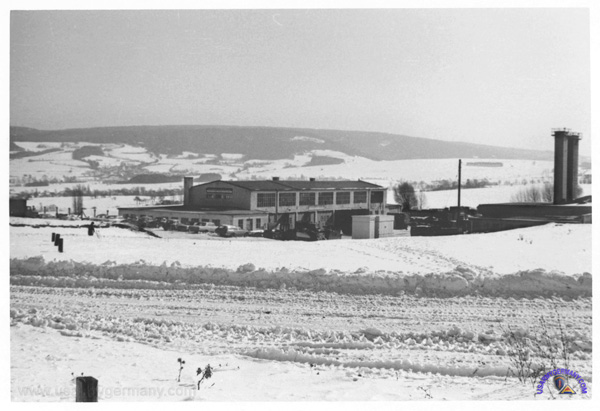 This is probably the squadron maintenance shop, Christensen Bks, Bindlach, late 1960s |
||||||||||||||||||||
| 1967 | ||||||||||||||||||||
| (Source: STARS & STRIPES, February 11, 1967) | ||||||||||||||||||||
It was announced that the 1st Reconnaissance Squadron border camp at Kronach was recently redesignated as Camp Sergeant Patrick Leonard. The camp was named after a Medal of Honor of the Indian War of 1870.
Present occupant of the camp is Troop C, 1st Rcn Sq, 2nd ACR. |
||||||||||||||||||||
| 1986 | ||||||||||||||||||||
| 2nd Battalion/Squadron, 2nd ACR | ||||||||||||||||||||
|
||||||||||||||||||||
| 1960 | ||||||||||||||||||||
| (Source: Email from Mallory Shannon, daughter of SGT Jack w. Shannon, 2nd Sq, 2nd ACR, 1960-1963) | ||||||||||||||||||||
| I am attaching photos which were taken during the 1960-1963 time period. My fatherwas was stationed at Warner Barracks, Bamberg and would rotate border patrol duties out of Harris Barracks with the Bundesgrenzschutz (German Border Guards). SFC Jack W Shannon was his name and he retired after 24 years in the US Army in Nov 1967. Proud Army Brat |
||||||||||||||||||||
| 1973 | ||||||||||||||||||||
| (Source: Email from Steve Wilton, 2nd Sq, 2nd ACR) | ||||||||||||||||||||
I joined the 2/2 ACR in September of 1973 as a PFC. I served my entire tour in 1st platoon, Troop E. I rotated back to the States as a SGT, in October of 1975. The Squadron was based in Bamberg and operated two border camps one at Coburg and one at Hof. In both camps we shared the base with Germen units. The way Squadron ran the camps, a Troop would rotate to the border sending two platoons to Hof and one platoon to Coburg. The tank company would augment the Coburg team with a platoon. Troops would be on border duty for about thirty days. When we would go to a major training area, Graf or Hohenfels one of the divisional cav squadrons would take the border mission for us. Usually the squadron from 3 ID.
There's not much else to say, our mission was the border. We ran daily patrols, manned 24 hour observation posts, manned an operations center and kept a two Sheridan ready reaction force on standby. Tactical training focused on recon missions, delay and passage of lines.
After I left 2nd ACR I served in tank battalions mostly in infantry divisions until 1992 when I was assigned as the 1SG of M Co 3/11 ACR. We ended up with the sad duty of shutting the regiment down. Once that was done I was transfered to Friedberg and then retired from the Army. In Germany at different times I served in 2/2 ACR, 1/64 AR 3 ID, 2/66 AR 2AD (fwd), 3/11 ACR, and 2/67 AR 1 AD.
I thought that you may have interest in these photos. It's probably not suitable for copying the pattern, but the colors are quite clear. The paint on these vehicles is new as you can see one of them isn't finished (Photo #1, M551 Sheridan on the right). That one is mine, E-14, 2/2 ACR. These vehicles are in the motor pool at the border camp in the city of Hof. I have the date as being in July of 1974. It's a personal photo taken by myself. The colors are quite stark when new, but once the paint aged and weathered a bit it seemed to tone down and get darker. Once that happened the scheme melted into the European background pretty well. I also have a reasonable photo of an M 109 in the same color scheme if you'd be interested in that. |
||||||||||||||||||||
|
||||||||||||||||||||
| 3rd Battalion/Squadron, 2nd ACR | ||||||||||||||||||||
| 1962 | ||||||||||||||||||||
| (Source: Email from Nelson Voke, 3rd Squadron, 2nd ACR, 1962-65) | ||||||||||||||||||||
Joined the Regiment in November 1962 as a first lieutenant and was assigned to Third Squadron in Amberg at Pond Barracks/Mohl Kaserne, first as a platoon leader in K Troop; then acting XO of I Troop. Made captain and took I Troop; next, became Squadron S2/Border Operations Officer. Later, went to Merrill Barracks in Nurnberg and was the Regimental Communications Officer for about ten months. Left the Regiment in the Summer of 1965.
|
||||||||||||||||||||
| 1966 | ||||||||||||||||||||
| (Source: Email from Frank Moseley, HQ/HQ Trp, 3rd Sqdn, 2nd ACR, 1966-68) (For more photos of 3rd Squadron and Pond Barracks, see Frank's photo pages on flickr) |
||||||||||||||||||||
|
||||||||||||||||||||
|
||||||||||||||||||||
| Border Operations | ||||||||||||||||||||
| (Source: 2nd ACR PAO, early 1980s; the briefing, however, was probably prepared in the late 1960s) | ||||||||||||||||||||
| BORDER OPERATIONS
Twenty-four-hours-a-day, seven-days-a-week surveillance on the border requires a special kind of combat organization. Because of its special versatility and its ability to maneuver and communicate, the 2d Armored Cavalry has been assigned to the mission of patrolling and protecting this sector of the border which separates the Free World from the Iron Curtain Satellites. The mission of the Regiment is to provide continuous surveillance of the border as an outpost of western civilization and to provide warning of impending movement of hostile forces into West Germany. The 2d Armored Cavalry serves as the "eyes and ears" of Seventh Army. The Regiment has three squadrons on line. The 2d Squadron is on the west, the 3d Squadron on the south-east, and the 1st Squadron in the center; Regimental headquarters and attached units are located at Merrell Barracks in Nurnberg near the center of the Regimental sector. Reconnaissance troops from the 2d Armored Cavalry's three squadrons occupy base camps in the Regimental border zone. Troops are normally rotated every thirty days to the squadron home stations and as a general rule no troop remains on border duty over thirty days at any one time. Border Surveillance is accomplished by means of Border Outposts at strategic points along the border, manned by reconnaissance personnel on a round-the-clock basis, supplemented by border patrols on the routes paralleling the border. Voice and CW radios as well as point-to-point telephone communications are utilized to insure an unbroken communications' chain for observation, patrolling and reporting. Patrols and Outpost personnel are briefed on their duties daily and are debriefed for information of significance daily after returning from their border duty tour. Border patrols are made up of men from scout sections of the reconnaissance troops. Each six-man section is a closely knit team; these men know each other and their jobs well; they have to, because their duty requires competence and a reliance on each other at all times. Along the border roads and lanes the five-man patrols travel in two jeeps, which always move close together. The first jeep is radio equipped, while the second mounts a machine gun. They are in constant radio communication with the border station, nearby patrols and observation posts. The 2d Armored Cavalry troopers in observation posts along the border have the responsibility of watching what their counterparts across the Iron Curtain are doing at all hours of the day and night. Light aircraft and helicopters make frequent swings along the border for aerial reconnaissance missions. The 10 place H-34 helicopter sometimes carries a team of combat-ready soldiers ready to assist border troops on short notice. The border is not a hospitable place. All roads between East and West are blocked. Armed guards have been placed at all crossing points. All bridges over main thoroughfares have been destroyed and the trickle of legal traffic across the border is being channeled over a few secondary, easily controlled roads. Along the frontier, defensive works, some still dating from the period of tension before World War II have been strengthened, extended and improved. Semi-military Soviet Satellite Police Forces, well trained and equipped with modern light infantry weapons patrol this border around the clock, enforcing rigid travel control measures. Electrified barbed wire fences, guard towers, trip flares and booby traps as well as field fortifications along the international boundary with Czechoslovakia have made this border the most effectively sealed international dividing line ever known in Europe. This barrier system is now being duplicated by the East Germans along the boundary between the German Federal Republic and the Soviet Zone of Germany. |
||||||||||||||||||||
| Logistics | ||||||||||||||||||||
| (Source: ALOG, Mar-Apr 1981) | ||||||||||||||||||||
| Logistics,
Cavalry Style by Captain Charles S. Fulmore The 2d Armored Cavalry developed this concept for logistics support of its wartime mission. Cavalry! The word brings to mind visions of horse-soldiers, clad in blue with high black boots and yellow-gold scarfs, riding through the foothills of the Dakotas. Oh yes, don't forget the red and white guidons whipping in the wind. Well, those days may be gone, but the cavalry is still alive and well. The horses have been replaced by M60 tanks, scout jeeps, and TOW Cobras, but the guidons have weathered the times and remain red and white. An assignment for a combat service support officer to a cavalry unit can be a unique and challenging experience, particularly when that unit is one of the only two armored cavalry regiments in the U.S. Army, Europe, responsible for the surveillance of the politically sensitive East German and Czechoslovakian borders. Troopers of the 2d Armored Cavalry Regiment can expect to spend in excess of 250 days a year away from their home station conducting border surveillance and training to fight. What this means is that the cavalry logistician will have the opportunity to practice his trade where it really counts - on the probable battlefield. Maximum use of available resources is practiced in this unit. This was demonstrated by the creation of the regimental service support area activity (RSSA) concept. |
||||||||||||||||||||
|
||||||||||||||||||||
| The second main part of the RSSA is the reports section. It receives all personnel and logistics reports from subordinate units and processes them to the appropriate agency. From the airdrop of individual combat meals to the pre-positioning of petroleum, all is controlled by the RSSA. The RSSA concept is now an integral part of the regiment's battle plan. The RSSA is to be essentially a mini-divisional materiel management center. The concept was developed with two purposes in mind. First, to provide a firm logistics base for the regiment, the RSSA is to coordinate the various support elements that come to the regiment in wartime. Second, the RSSA will allow the regimental S1 and S4 the time needed for effective logistics planning in conjunction with tactical planning. The concept also allows for these two officers to be physically located with the regimental commander in the tactical operations center so they can provide him with direct information during operations. The development of the RSSA concept was no easy task. Imagine creating an organization from existing internal resources and assets without degrading the capabilities of other elements within the regiment. The concept was transformed into reality and was practiced during REFORGER '79. |
||||||||||||||||||||
|
|
||||||||||||||||||||
| Related Links: | ||||||||||||||||||||
|
||||||||||||||||||||
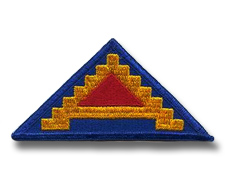
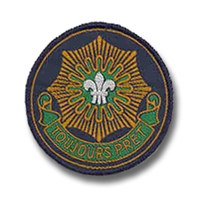
%20600.jpg)
%201%20600.jpg)
